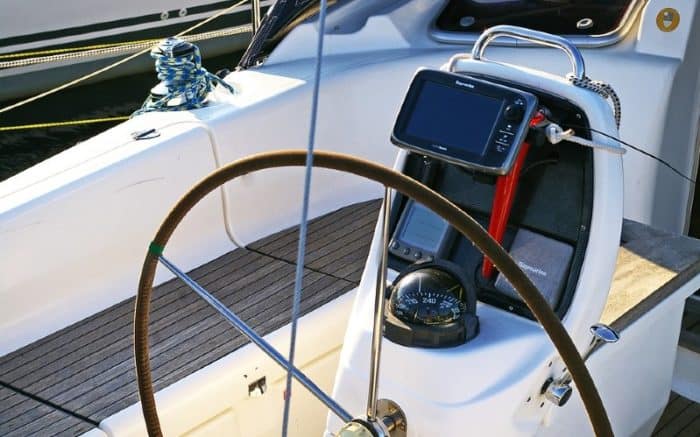Boat Speed Calculator
Most of us want to know our boat’s top speed but don’t know how to calculate it. And, just as likely, we don’t think we need to. GPS is a good way to figure out your boat speed with no effort. It does all the work for you with just a glance. But it’s not always going to be available, especially if there’s a service disruption or an issue with your power. Plus, what if you want to know before you get on the water? Fortunately, calculating boat speed doesn’t have to be that hard. Let’s take a look at what you need to know.
The Basics of Calculating Boat Speed
You’ll need to know a handful of factors when calculating boat speed. This is why most of us don’t like to calculate it ourselves. And why a calculator tool is so much more helpful. However, we thinking knowing the basics behind how and why the calculator works is important, too. Even if you never need to write it out by hand.
You’ll need to know your boat’s shaft horsepower as well as its displacement. You’ll also need to include Crouch’s constant which varies based on the kind of boat we’re talking about. This number is something boat designers use when designing hull types. For instance, average runabouts have a Crouch constant of 150. A racing catamaran can be up to 230. High speed runabouts will be 190.
Horsepower
Horsepower works out to 550 foot-pounds per second. That equals 746 watts of energy. A number of factors affect how much horsepower is ideal for your boat. It relates to size and hull shape as much as everything else does. The general rule of thumb for horsepower is that for each horsepower you need about 5 to 40 pounds of weight. Too little horsepower and you can burn your engine out far too quickly. Too much horsepower can be dangerous. In fact, every boat is required to have a maximum horsepower rating. If you swap out your outboard motor for a more powerful one you risk damaging the boat, losing control, and worse. When it comes to HP, bigger is not always better.
Displacement
Displacement refers to the volume of water your boat displaces. This is then converted to weight to, in practical terms, you can consider displacement the boat’s weight. A racing hydroplane might displace 6700 lbs, for instance.
A Speed Calculation Example
Speed = square root of (horsepower/displacement) X Crouch Constant
Let’s take a look at an example to get a better idea with a smaller boat.
Speed = square root of ( 50 hp/800 lb) X 150
Speed = 37.5 mph
In a pinch you can work this out on your own with a pen and paper. Or, more likely, the calculator on your phone. A calculator tool makes it super easy, of course. But if you’re ever in a pinch with no power handy, it’s good to know the math behind it.
Horsepower Calculations
Another big concern for many boaters deals with horsepower. Like we said earlier, you need to have the right amount of horsepower for your boat. Too little is a struggle that can burn your engine. Too much can damage the boat and lead to accidents.
Remember, when your boat was designed, it was designed with these calculations in mind. The hull and transom are meant to support only a certain amount of pressure and weight. Even a small increase in horsepower can dramatically increase the pressure on your hull. It will also increase the torque on your transom. If it goes too far beyond manufacturer recommendations you could collapse the hull entirely.
Does this mean you can never exceed the horsepower rating of your hull? Not exactly. Accommodations need to be made. You would have to reinforce the hull and transom to handle the higher horsepower. Obviously we’re into some heavy work at this point. If you’re not sure right now how to reinforce a boat hull, you may want to stay within the established limits. Another thing to consider is whether or not you have a self-draining cockpit. A new engine could throw off the balance of your boat. That could make water enter the scuppers and soak the boat.
If you need to buy a new engine you can calculate the horsepower using the same formula. That’s the beauty of any math formula, you can solve for any single number in the equation if you know the others. So, if you want to know horsepower to achieve your desired top speed, do a reverse calculation. Let’s say in this case you want your boat to hit 50 miles per hour.
Horsepower = (speed/ crouch) squared x displacement
HP = (50/150) squared x 800
HP = 88.89
In this case, with your small boat displacing 800 lbs, if you want to reach 50 miles per hour, then you need a 90 hp engine.
One thing to remember about upgrading an engine is weight. Usually, a higher horsepower engine is also going to be heavier. The change in displacement obviously changes the figures. That said, it’s not always the case. Many modern engines do a very good job of keeping weight down.
What About Hull Speed?
Another formula for calculating hull speed for a displacement hull you might see is fairly simple. This one does not require as many numbers but also doesn’t give you the most accurate answer. The formula is
1.34 x the square root of the waterline length in feet, or
2.43 x the square root of the waterline length in meters.
For example, if you had a 16 foot boat, the square root is 4. So the formula would be 1.34 X 4 = 5.46 knots.
1 knot equals about 1.15 miles per hour so you can calculate this to mph if that’s easier for you. That takes you to 6.3 miles per hour, give or take.
This is the theoretical top speed of the vessel. That said, many factors can get in your way. How much horsepower you have, propeller slip, the condition of your boat and more alter this. Even water conditions and hull cleanliness can change your top speed.
Doesn’t Waterline Length Change?
Why does this formula exist and the other formula as well? This calculation is older and not as accurate. For instance, your waterline length can actually change as your speed increases. Thus, the accuracy is very suspect. Plus, when you add power sufficient enough to overcome hull drag, this number no longer applies. That means when you’re using your motor for propulsion, our original equation is far more useful. This one here is really more something you should be aware of. You may find it when you Google boat speeds and wonder why the different formulas exist. Even boat manufacturers ignore this calculation these days. It just doesn’t apply to modern boat making in any reasonable way.
Insurance Issues
A final note you might want to consider if you’re looking to soup up your boat. Let’s say you can get a higher horsepower engine and really boost your overall speed. That can be fun if you do it safely and, of course, safety is the number one concern. But there is another issue that may make you think twice. At the very least you’ll want to research it further to make sure it’s not a problem. Insurance.
Check with your insurance company before installing a new engine, especially if it boosts the horsepower. If you go past what the manufacturer recommended, you could be in trouble. If an accident occurs your insurance company may deny a claim.
Worse, if you are in an accident with an overpowered engine, the fault could automatically become yours. You may be considered responsible or negligent for damage caused as a result. Your insurance will not cover you and the result could be lawsuits coming your way. As such, check with any state boating regulations before you commit to anything. No sense spending time and money on something you can’t or shouldn’t do.
The Bottom Line
Knowing how to calculate horsepower and boat speed is a very useful skill. Having a handy calculator is also worthwhile. This allows you to get a better idea of how long any trip will take, how much weight your vessel can carry, and more. Plus, let’s be honest, it’s kind of cool.
Categories: Tools and Calculators













1 Comment
Craig Dahlke on March 19, 2022
Great article. In the late 1970’s I drove a recitative’s 8′ hydroplane that had a 40hp Mercury. I kneeled on the floor, and it had a dead man’s throttle. It was the fastest boat I have been in. Roughly how fast could this hydroplane go? Craig